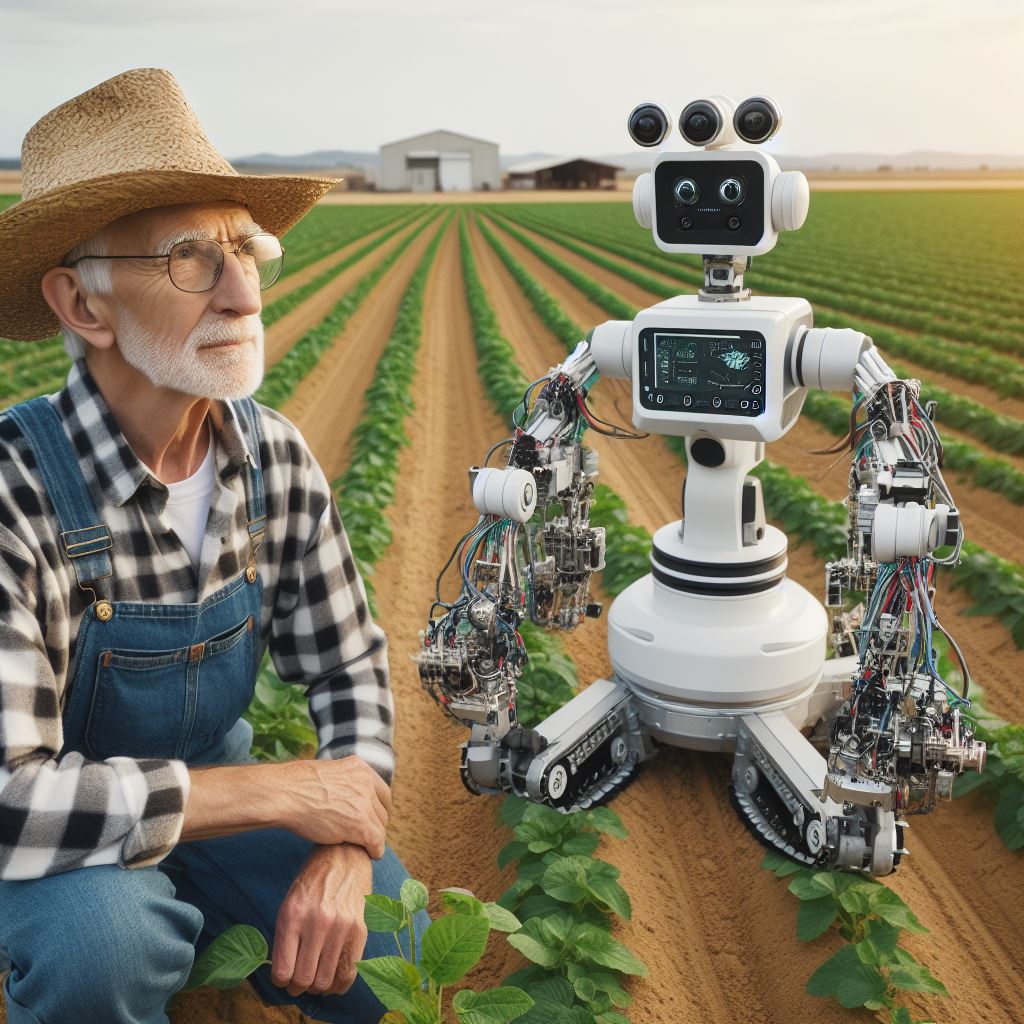Introduction
Agri robots are revolutionizing the agricultural industry by automating various tasks and increasing efficiency.
Equipped with sensors and AI, they optimize resource use and enhance efficiency.
Agri robots reduce labor costs, minimize chemical usage, and improve yield consistency.
Their versatility enables precision agriculture, allowing farmers to manage large-scale operations with unprecedented accuracy, ultimately advancing sustainable farming practices for a growing world
Importance of Agri Robots in Shaping Farm Policy Changes
The importance of agri robots in shaping farm policy changes cannot be underestimated.
They have the potential to address labor shortages, improve productivity, and reduce environmental impacts.
Agri robots offer numerous benefits, including increased precision, reduced costs, and enhanced crop yields.
Their ability to perform tasks such as planting, weeding, and harvesting with precision and speed makes them indispensable in modern farming.
With the growing global population and increasing food demand, agri robots have become crucial to meet the challenges of sustainable farming.
Government policies play a significant role in supporting the adoption and implementation of agri robots.
Farm policy changes need to align with the advancements in technology and provide incentives for farmers to invest in agri robots.
By promoting research and development, governments can foster innovation and ensure that agri robots continue to shape the future of farming.
Furthermore, policymakers should consider creating regulatory frameworks that address concerns regarding privacy, safety, and employment implications.
Farmers, on the other hand, need access to training and support to effectively integrate agri robots into their operations.
In essence, agri robots have emerged as a game-changer in agriculture, driving farm policy changes that prioritize sustainability, productivity, and competitiveness.
Transform Your Agribusiness
Unlock your farm's potential with expert advice tailored to your needs. Get actionable steps that drive real results.
Get StartedDefinition and types of agri robots
Definition of agri robots
Agri robots are autonomous machines designed to perform agricultural tasks, reducing the need for human labor.
Overview of various types of agri robots
- Field robots: These robots are used for soil preparation, planting seeds, and applying fertilizers and pesticides.
- Harvesting robots: These robots are capable of selectively harvesting crops, reducing human labor and increasing efficiency.
- Milking robots: These robots automate the milking process, improving productivity and reducing stress on dairy animals.
- Weeding robots: These robots use computer vision and machine learning algorithms to identify and remove weeds without damaging the crops.
- Sorting and grading robots: These robots sort and grade fruits and vegetables based on size, color, and other parameters, enhancing efficiency and accuracy.
Agricultural robots hold transformative potential, reshaping the industry through heightened productivity and diminished reliance on manual labor.
Infused with cutting-edge technologies like artificial intelligence, computer vision, and sensors, these machines specialize in diverse field tasks.
From automated seed planting, fertilizing, and pesticide application to precision harvesting, the robots optimize efficiency, saving time and fostering sustainable farming practices.
Milking robots, prevalent in dairy farms, detect and automatically perform milking, alleviating stress on cows and enhancing productivity.
Weeding robots employ advanced imaging and machine learning to identify and remove weeds, promoting eco-friendly and cost-effective solutions.
Post-harvest, sorting and grading robots ensure consistent quality by automating the categorization of fruits and vegetables based on size, color, and ripeness.
In general, agri robots encompass a wide range of machines designed to improve efficiency, reduce labor requirements, and enhance productivity in agriculture.
With advancements in technology, these robots have the potential to reshape farm policies and bring about significant changes in the agricultural sector.
Benefits of Agri Robots
Increased Efficiency and Productivity
Agri robots have revolutionized farming by increasing the speed and accuracy of various agricultural tasks.
These robots can efficiently perform tasks such as planting seeds, applying fertilizers, and harvesting crops.
Their precise navigation systems and algorithms ensure that every action is executed with utmost precision.
As a result, farmers can complete these tasks faster and more efficiently, leading to higher productivity.
Cost Reduction in Labor and Resources
One of the major benefits of agri robots is the significant reduction in labor costs for farmers.
Previously, large teams of workers were required to perform manual tasks on farms, leading to high labor expenses.
However, with the introduction of agri robots, many of these tasks can now be automated, reducing the need for human labor.
Furthermore, these robots can optimize the use of resources such as water, fertilizers, and pesticides, minimizing wastage and reducing costs.
Improved Crop Quality and Yield
Agri robots play a crucial role in improving the overall quality and quantity of agricultural produce.
Through advanced sensors and imaging systems, these robots can monitor crops closely and identify any signs of plant diseases or nutrient deficiencies.
This early detection allows farmers to take timely action, ensuring healthier crops and maximizing yield.
Additionally, agri robots can also optimize the application of fertilizers and pesticides, preventing overuse or underuse, resulting in improved crop quality.
Reduction in Chemical Use and Environmental Impact
Agri robots contribute significantly to reducing the use of chemicals in agriculture, benefiting both the environment and consumers.
With their precise application systems, these robots can apply fertilizers and pesticides only where necessary, minimizing overall chemical use.
This targeted approach reduces the environmental impact of agriculture by preventing the unnecessary spread of chemicals in soil and water systems.
Showcase Your Farming Business
Publish your professional farming services profile on our blog for a one-time fee of $200 and reach a dedicated audience of farmers and agribusiness owners.
Publish Your ProfileMoreover, by reducing chemical use, agri robots promote sustainable farming practices, protecting biodiversity and maintaining a healthier ecosystem.
Increased Safety and Reduced Physical Labor for Farmers
Agri robots play a vital role in ensuring the safety and well-being of farmers.
By automating physically demanding tasks such as heavy lifting or repetitive motions, these robots reduce the risk of injuries for farmers.
Robots can handle tasks such as lifting heavy loads or operating machinery, which eliminates the need for farmers to exert themselves physically.
This reduction in physical labor not only improves the safety of farmers but also enhances their overall well-being and work-life balance.
In summary, the benefits of agri robots in shaping farm policy changes are vast and impactful.
These robots have proven to increase efficiency and productivity, reduce labor and resource costs, improve crop quality and yield, minimize chemical use and environmental impact, and enhance the safety and well-being of farmers.
The adoption of agri robots in agriculture is crucial to meet the growing demands of a sustainable and productive farming industry.
Read: Latest USDA Organic Regs: What’s New?
Implications of agri robots on farm policy
Agricultural robots have the potential to bring about significant changes in farm policy, impacting various aspects of the agricultural industry. Here are some key implications:
Labor and immigration policies
Agri robots can alleviate labor shortages by performing tasks traditionally done by human workers.
This raises concerns about changes needed in labor and immigration policies to accommodate automation.
Governments may need to revise visa regulations to allow for the importation of skilled robot technicians instead of human labor.
Need for revised regulations and standards for agri robots
The introduction of agri robots calls for new regulations and standards to ensure their safe and efficient use.
Government agencies need to establish guidelines for the development, deployment, and operation of these robots.
This would involve comprehensive safety protocols, compliance measures, and regular inspections to prevent accidents or malfunctions.
Economic considerations and subsidies
Adopting agri robots involves significant costs for farmers, including purchasing, maintenance, and training expenses.
Governments may need to provide subsidies or financial incentives to encourage farmers to invest in this technology.
Economic policies should also consider the potential job displacement and impact on farm incomes that may arise from robot implementation.
Impacts on rural communities
The integration of agri robots may have social and economic consequences for rural communities.
Job displacement due to automation could affect local economies and livelihoods.
Policymakers must consider strategies to support affected communities through retraining programs or alternative employment opportunities.
Overall, the implications of agri robots on farm policy are far-reaching. Labor and immigration policies need to adapt to the automation of agricultural tasks, while revised regulations and standards are necessary to ensure the safe and efficient use of agri robots.
Economic considerations, such as subsidies and job displacement, should also be accounted for, along with plans to mitigate the impacts on rural communities.
By proactively addressing these implications, policymakers can shape farm policies that promote the responsible adoption of agri robots while safeguarding the interests of farmers and rural communities.
Read: Agriculture Acts 2024: Changes and Effects
Challenges and concerns
Initial investment and affordability
- The adoption of agri robots requires a significant initial investment.
- Many small-scale farmers may find it difficult to afford the high costs of purchasing and maintaining these robots.
- The lack of financial resources and availability of loans further exacerbates this affordability challenge.
- Governments and agricultural organizations must find ways to make agri robots more accessible and affordable for farmers.
Technological limitations and maintenance
- Agri robots are still evolving, and their technological limitations pose challenges.
- Issues such as limited battery life, accuracy in crop detection, and navigation difficulties need to be addressed.
- Maintenance of these complex machines requires specialized skills and training, adding to the overall costs.
- Ongoing research and development efforts are crucial to overcoming these technological challenges and ensuring reliable performance.
Ethical considerations on job displacement
- Agri robots have the potential to replace human labor in various agricultural tasks.
- This raises concerns about the impact on employment and livelihoods of farmers and agricultural workers.
- The transition to automation should be accompanied by measures to provide alternative employment opportunities.
- Training programs and skill development initiatives can help workers adapt to the changing landscape of agriculture.
Potential risks to cybersecurity
- As agri robots become more connected and integrated within farm systems, they are vulnerable to cyber threats.
- Hackers could exploit vulnerabilities in the robots’ software or gain unauthorized access to sensitive farm data.
- Farmers and agri robot manufacturers must prioritize cybersecurity measures to protect valuable information and prevent disruptions.
- Regular software updates, data encryption, and rigorous testing protocols can help mitigate the risks of cyber attacks.
Ultimately, while agri robots offer numerous benefits, they also present various challenges and concerns.
Addressing these challenges, such as affordability, technological limitations, job displacement, and cybersecurity risks, is crucial for successful implementation.
Collaboration between governments, agricultural organizations, and technology providers is essential to ensure the responsible adoption and effective integration of agri robots in farm policy changes.
Read: Rural Development Funds: How They Work in 2024

Case studies of agri robot adoption and policy changes
Japan: Successful integration of agri robots and policy changes
Japan has been a pioneer in the adoption of agri robots, successfully integrating them into their agricultural practices.
The Japanese government recognized the potential of these robots in addressing labor shortages and improving efficiency in the farming sector.
The government implemented several policies to support the adoption of agri robots.
They provided financial incentives, such as subsidies and tax breaks, to farmers who invested in these technologies.
This encouraged farmers to embrace agri robots and facilitated their integration into existing farming systems.
Through extensive research and development, Japanese companies developed a range of agri robots to cater to different farming needs.
These robots can perform tasks like planting, weeding, harvesting, and even monitoring crop health.
Their advanced technology and precision have significantly increased productivity and reduced the need for human labor.
The successful integration of agri robots in Japan has led to improved crop yields and reduced costs for farmers.
It has also addressed the issue of labor shortage in the agricultural sector, as the aging population in Japan has hindered traditional farming practices.
Showcase Your Farming Business
Publish your professional farming services profile on our blog for a one-time fee of $200 and reach a dedicated audience of farmers and agribusiness owners.
Publish Your ProfileNetherlands: Potential challenges faced in implementing agri robots
In the Netherlands, the implementation of agri robots has been met with some challenges.
While the potential benefits are acknowledged, there are concerns about the impact on employment in the agricultural sector.
The Dutch government has been cautious in promoting agri robots due to the fear of job displacement.
They recognize the need to strike a balance between automation and maintaining employment opportunities for people in the farming industry.
Another challenge faced by the Netherlands is the adaptation of agri robots to suit their unique farming landscape.
Unlike Japan, which has large-scale, flat fields, the Netherlands has smaller, fragmented plots of land with complex terrains.
Developing robots that can navigate these terrains effectively has proven to be a challenge.
Comparison of different approaches and outcomes
When comparing the approaches taken by Japan and the Netherlands in adopting agri robots, we see notable differences in policy changes and outcomes.
Japan’s proactive approach, with supportive policies and incentives, has resulted in successful integration of agri robots into their farming practices.
The positive outcomes include increased productivity, improved crop yields, and reduced labor shortages.
The Netherlands, on the other hand, has been more cautious in implementing agri robots due to concerns about job displacement and challenges posed by their unique farming landscape.
While they recognize the potential benefits, further research and development are needed to overcome these challenges.
It is essential for policymakers to carefully consider the specific needs and challenges of their agricultural sector when formulating policies related to agri robot adoption.
They must strike a balance between automation, job creation, and sustainable farming practices.
Overall, the case studies of Japan and the Netherlands highlight the importance of policy changes in shaping the adoption and integration of agri robots.
With the right policies in place, agri robots have the potential to revolutionize the farming industry and address various challenges faced by farmers worldwide.
Read: Agribusiness and Zoning Law Trends
The role of research and development
Government funding and support
- Government funding plays a crucial role in promoting research and development of agri robots.
- Financial support enables scientists and engineers to conduct studies and develop innovative technologies.
- Investing in research ensures that farmers have access to advanced tools for efficient and sustainable farming.
- Government initiatives can also help create regulatory frameworks and standards for agri robots.
- Public-private partnerships can further amplify the impact of government funding and support.
Collaboration between farmers, academia, and industry
- Collaboration between farmers, academia, and industry is vital in driving agri robot development.
- Farmers provide valuable insights and practical knowledge for designing robots that meet their specific needs.
- Academic institutions contribute by conducting research, testing prototypes, and training future experts in the field.
- Industry partners bring technical expertise and resources to further refine and scale up robot technologies.
- Pooling together these different perspectives and expertise accelerates innovation in the sector.
Importance of continuous innovation and improvement
- Continuous innovation and improvement are crucial for agri robots to shape farm policy changes effectively.
- New technologies and features can address emerging challenges such as climate change and labor shortages.
- Regular updates and advancements in robot capabilities enable farmers to enhance productivity and reduce costs.
- Improving the efficiency and effectiveness of agri robots contributes to sustainable agricultural practices.
- Investing in research and development ensures that agri robots remain at the forefront of agricultural transformation.
All in all, the role of research and development in shaping farm policy changes through agri robots cannot be overstated.
Government funding and support ensure the necessary resources are available for innovation.
Collaborations between farmers, academia, and industry bring together diverse perspectives and expertise to drive progress.
Continuous innovation and improvement are essential for agri robots to address evolving challenges and contribute to sustainable farming practices.
By investing in research and development, we can build a future where agri robots play a pivotal role in shaping farm policies and revolutionizing agriculture.
Conclusion
As we conclude our discussion on agri robots and their impact on farm policy changes, it is important to recap the key points.
Agri robots have proven to be essential tools in modern agriculture, offering numerous benefits to farmers and the industry as a whole.
These robots not only increase efficiency and productivity but also contribute to sustainable farming practices and a reduction in labor costs.
By automating various tasks such as planting, harvesting, and monitoring crops, agri robots allow farmers to optimize their operations and make informed decisions based on real-time data.
Moreover, they can help address challenges like labor shortages, climate change, and the need for precision agriculture.
As technology continues to advance, the role of agri robots in shaping farm policy changes cannot be underestimated.
Encouragement for policymakers to take proactive measures in embracing agri robot technology
It is crucial for policymakers to recognize the potential of these robots and take proactive measures to embrace and support their integration into agricultural practices.
This includes creating policies and regulations that encourage the adoption of agri robots, providing incentives for farmers, and investing in research and development.
By doing so, policymakers can ensure that their jurisdictions remain competitive in the global agriculture market and promote sustainable farming practices.
In closing, agri robots have the power to revolutionize the agricultural industry and shape farm policies for the better.
It is time for policymakers to embrace this technology and seize the opportunities it presents for increased productivity, efficiency, and sustainability in agriculture.




